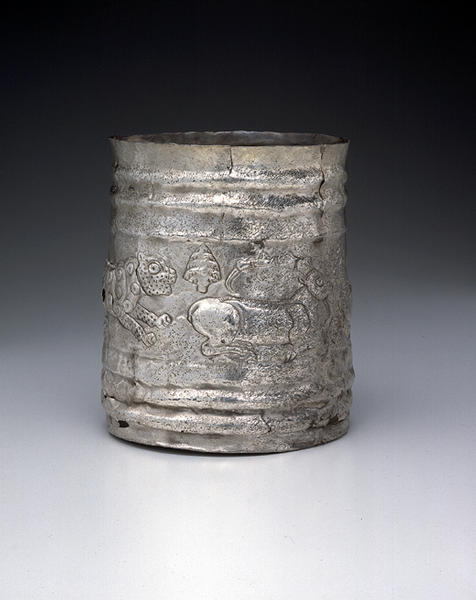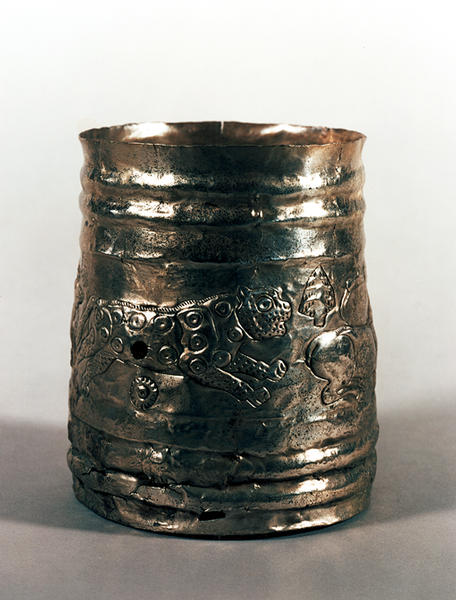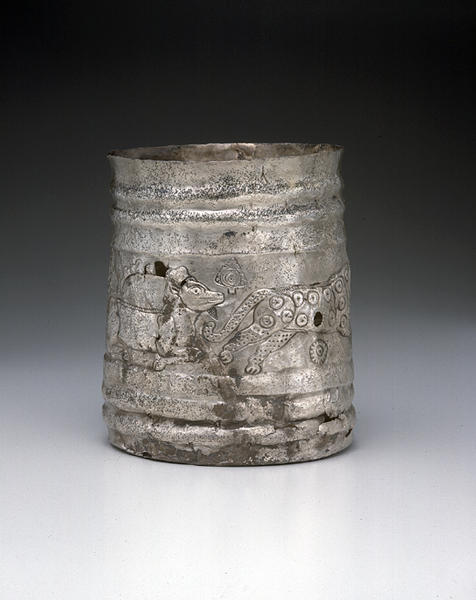動物文円筒杯
- 西中央アジア
- 紀元前3千年紀後期-紀元前2千年紀初期
- 銀
- H-12.1 D-10.3
解説(古代バクトリア遺宝展)
前三千年紀後期―前二千年紀初期
銀
高11.0 cm 径9.5 cm
この銀器の胴部表面には、疾駆するように脚を広げた豹と座位の野生山羊が見られる。これらの動物の間には、樹木形の意匠と天体のような意匠が刻まれている。樹木形の中には円形が刻まれているものも見られる。これは一見、豹が野生山羊を追いかける場面と受け取られるが、座位の山羊と温和な表情の豹は死闘の場面を構成しているようには見えない。古代西アジアでは豹の星座と野生山羊の星座が存在したが、これらは前四千年紀頃には春分の日の出直前の空に顕著に見られたものであって、豹と野生山羊の組み合わせはおそらく新年の到来を象徴したものと思われる。そしてイラン高原では、古くから野生山羊の神霊が蛇を掴む意匠が印章に表現されてきたが、おそらくこれも生命の源の水を野生山羊の神霊が司ることを示していたのであろう。野生山羊、樹木及び天体意匠の組み合わせは南イラン・エラムの前3000年頃の印章に頻繁に見られるが、エラム文化の影響を受けた東イラン・西中央アジアでこのような芸術的形象表現に結実したものではないか。メソポタミアでは前三千年紀には野生山羊の星座は水瓶座と山羊座に分かれ、古代西アジアでは春分の日没直後の空に見られる牡牛座と獅子座を新年の象徴としたと考えられる。イラク・ディヤラ川流域のテル・アグラブ出土、紀元前三千年紀頃の円筒印章にもこの樹木形の中に円形を組み合わせた意匠があり、更に植物意匠、ライオンと牡牛の闘争意匠とを組み合わせたものがあるが、当時のこれら象徴的な意匠が重要な役割を担っていたことがうかがえる。
Catalogue Entry(Bac#006)
Late 3rd‐early 2nd millennium B.C.
Silver
H. 11.0 cm, Dia. 9.5 cm
The torso surface of this silver cup is decorated with a leopard with legs spread as if running and a seated ibex. Plant forms are shown between these animals and designs which look like stars. Circles can be seen carved in the midst of the tree forms. At first glance this looks like a scene of a leopard hunting the ibex, and yet the seated ibex and leopard with mellow expression do not seem to construe a death attack scene. Ancient west Asia astronomy included both a leopard constellation and an ibex constellation, and around 4th millennium BC, these two constellations could be seen clearly in the spring equinoctial sky just before dawn. Thus it is thought that a combination of leopard and ibex probably symbolized the arrival of the new year. Further, in the Iranian highlands designs of the god spirit of the ibex grasping a snake have appeared since antiquity on seals, and this is thought to symbolize the god of the ibex ruling over the source of life, water. The combination of ibex, tree, and star design frequently can be seen on seals from Elam in southern Iran ca. 3,000 BC, and thus may have existed as an artistic expression in eastern Iran and western Central Asia under the influence of Elamite culture. In Mesopotamia in the 3rd millennium BC, the ibex constellation was divided into the Aquarius constellation and the Capricorn constellation, while in ancient western Asia, the Taurus and Leo constellations could be seen right after the sun set at the spring equinox and came to symbolize the new year. A cylindrical seal from ca. 3,000 BC excavated at the Tell Agrab site on the Diyala River region of Iraq has this same motif combining a tree with a circular form, there combined with other plant motifs and a battle scene between a lion and a bull. Thus we can imagine that these symbolic designs had some important role in the culture of that period.


